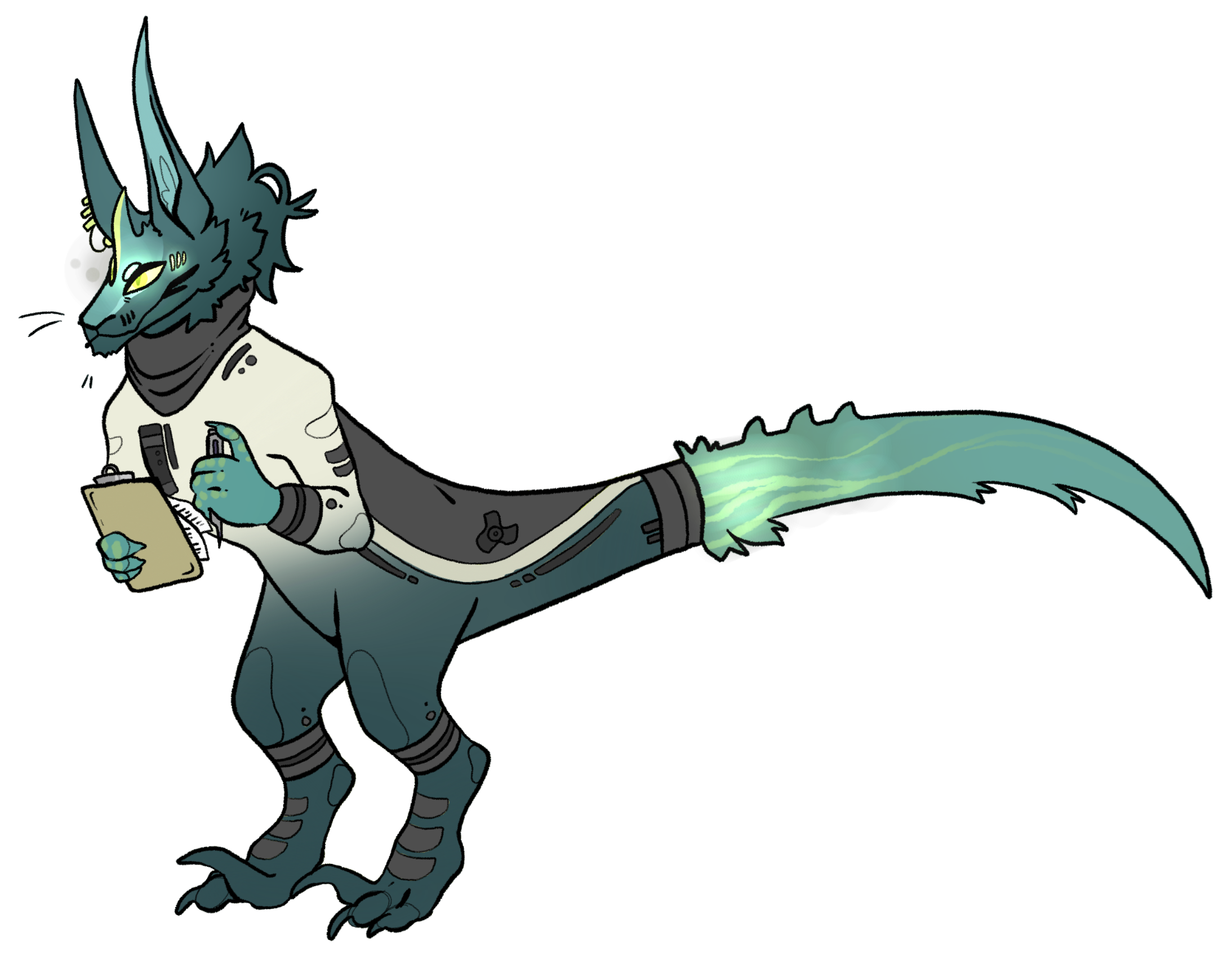The Space Age [Simplified]
Technology is advanced in Ptitheros. Aura and biomechanics are an emerging field of study. Many scientists are fascinated by everything aura can do. Due to how difficult aura is to control, normal ptithians were unable to make the powerful energy breakthrough needed to make the first spaceship engine.
At first, the world thought the bigwig scientists in Nox would reach space first. Instead, a tinkerer from Tucruitora did. She was a talented inventor and she had a friendly lindost assist her. Because of her lindost friend, she created the strong aura machines needed for a spaceship. She created the first Voyager spaceship and went to space.
After her experiments, this first astronaut shared her blueprints to fine-tune it and eventually sold her work to the governing body. All the kingdoms received the spaceship technology and a new project made by all the kingdoms was born. They wanted to create a space station.
Station Zariel was completed. It became the source of all things space discovery, exploration, and research. Scientists, adventurers, economists, and more now live on the station for months at a time to discover new things.
The Space Age [Full]
During the mid-years of the C.A. Era technology made a major jump. Over the century or so the containment and biomechanical engineering between aura and creature has been studied and breakthroughs made often as understanding and a desperate curiosity engaged scientists across the globe.
The difference between god and mortal depends on a creature's innate ability to harness the capabilities of aura, for aura has no limits and transcends the laws of the universe. By controlling new capabilities of aura a society can advance, but this is slowed because of natural aura-levels in creatures. Even the high-aura Ptithians can merely conduct spells and runes, but even those have limitations. Intelligence and engineering can only create the ideas, the concepts, but something greater is needed to make those concepts a reality.
The world believed one of the esteemed inventors of Nox would reach space first. After all, all initial advancements in aura had come from Nox, but no, it came from a nobody in the capital city of Tucruitora. In the capital was a lefika who worked as a linguistics specialist, but she found no joy in her work. A tinkerer and inventor at heart, with a love for space and exploration. The scientists at Nox paved the way through the aura technology she needed and she managed to take things even farther. Although no trained Nox specialist, Tektite tinkered and crafted in the basement of her own home for years and years to pursue a project she wasn't even sure had an end in sight. She wanted to make the very first machine that would take her to space. Her mixed and dappled knowledge on many things made her ideas good, but never solid. Despite this, she made trade connections in Nox using her father's name as leverage, and got ahold of any materials she needed. She also had help from something no engineers in the north had; a lindost, one of the most aura-powerful creatures known to Ptitheros.
The upcoming inventor, with the help of her friendly lindost, created stronger aura tech and figured out one of the hallmark steps to space transportation: propulsion, using a condensed aura orb that provided high amounts of controllable energy and magic that could be altered. Using this new energy technology, Tektite developed a ship that would make use of it. The only material strong enough to handle the energy would be allumnix, the common plant-based metal used for armor and capsule shells, whereas the indestructible roots of the honeycomb trees were used to tie the whole thing together. In the end, a ship was made. A small unit that the scientist nicknamed the Voyager.
The lefika and the lindost brought the Voyager out into the desert, where Tektite risked her life with a test drive of it. Luckily, all went well. The vast reaches of space where no longer a mystery and the first astronaut of Ptitheros returned to the ground and eagerly brought her blueprints to some other engineers she kept in touch with in Tucruitora. The others were amazed and helped fine-tune her updated features before it was eventually brought before the governing royal body of the city.
The Tucruitora government reviewed the new technology, witnessed it in action, and paid Tektite handsomely for free use of her creations for the betterment of all Ptithians. Patents were given, Tektite got to quit her old job and joined a circle of renown scientists up in Nox to further her own space technology so that many more Ptithians could feel the joy she had when seeing the planet from high above. Eventually, all of the kingdoms received info on the voyager tech and sent money towards a new, anticipated project: a space association, encompassing all kingdoms across Ptitheros.
It took a few decades, reengineering a little space ship with a simplified aura orb core into something worth the funding of all kingdoms was no easy task. The new aura tech was torn apart, whittled down so that scientists everywhere could understand how the lefika had done it, and thus, her project could be recreated all over the world. A wide-scale 'group' project, anyone who wished to further space exploration could if they wanted to, but the central group of scientists (with Tektite) were tasked with the project that took over 3 decades. A space station the size of a small island, fueled by an aura core so large and dangerous that only a lindost could work with it safely. So, Tektite's friend was a key assistant to the creation.
Station Zariel was completed. A massive space station resting within the planet's orbit, slowly drifting overhead of Ptitheros. It became the source of all things space discovery, exploration, and research. With the introduction of the station and the many more Voyagers found across Ptitheros, built by savvy tinkerers who wanted to reach the stars, there became a boom in space-related occupations. Scientists, adventurers, economists, and more now live on the station for months at a time to discover new things.
From then on, things have settled down. Although not a new era, many call the day that 'the initial astronaut' made it to space created a new age: The Space-Age of Ptitheros. The first astronaut, Tektite, presently works as a lead decision maker for the managing group on Station Zariel, but is often out doing her own exploration. Like herself, many other Ptithians follow said path of adventure. The world has expanded past the atmosphere, both the good and bad sides of society, space is not a safe haven despite how infinite it is.
Ptitheros searches for new questions, answers, and life unlike its own. What will the era of space travel unearth as the universe is now within reach.

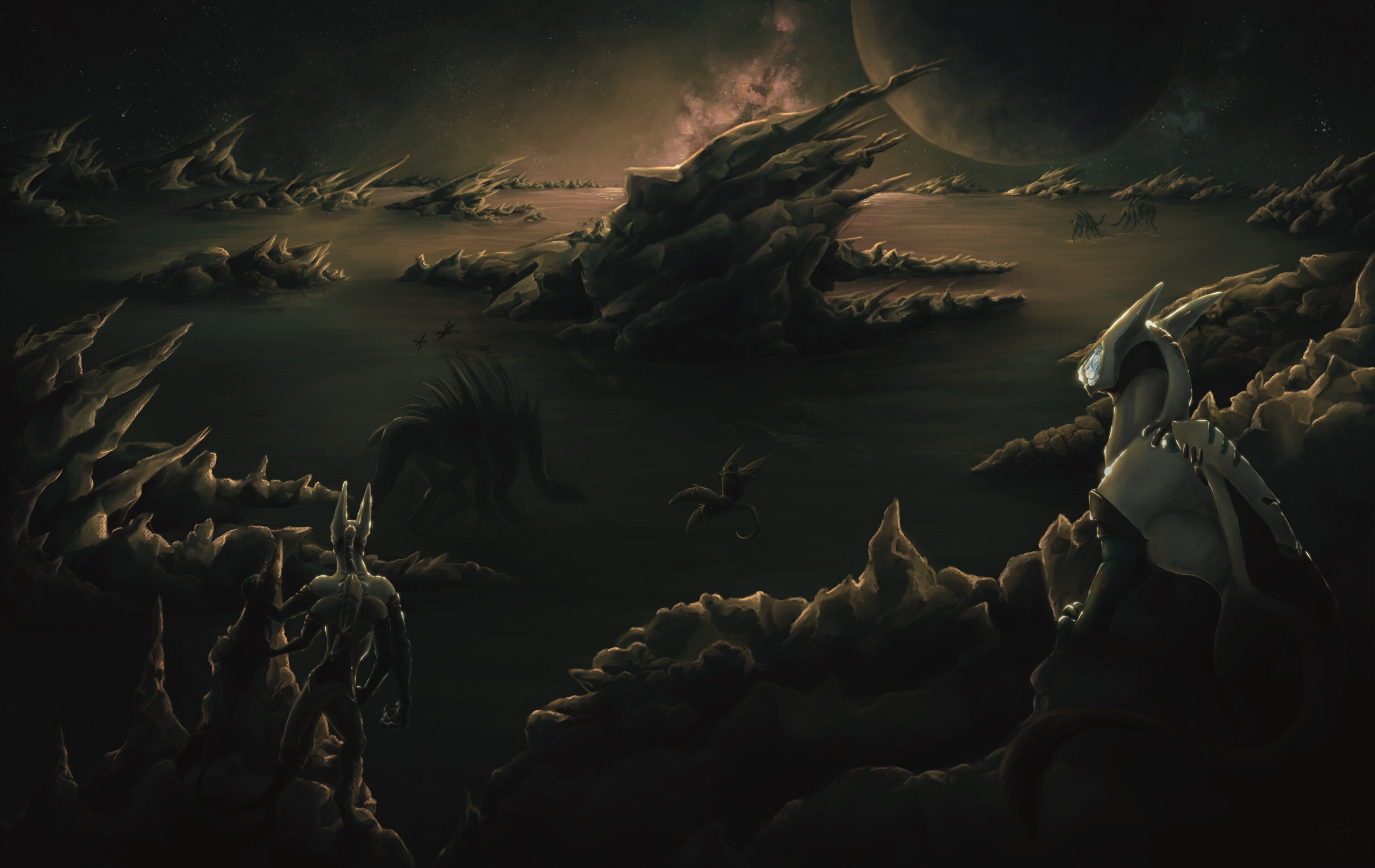
Daily Life
Station Zariel has areas for public activities, private wards, health branches, science branches, authority branches, and anything else necessary for a station. Although the entire station is difficult to navigate without a map, most who reside there do not have to wander beyond the public zones and their respective occupational branches.
The hub level is where daily life occurs, there are hundreds of shops, restaurants, and places to visit or relax when not on the job. Anyone is allowed to open a place as long as they get a permit.
Depending on the individual, their ranking, and the family they bring with them, their ward assignment is different. For basic ranks on their own, they receive a room in the private wards (hub level). For basic ranks with a family, they receive a room in the larger family wards (hub level). For administration and high ranks, they receive a room in the administration wards (authority level).
Depending on the ptithian’s job, they report to certain wings on the station. Most scientific jobs are on the aura level, businesses are on the hub level, and administration jobs are on the authority level.
Space Stations
Station 001 Zariel
All Ptitheros spacecraft, including stations, pods, and more, are built out of natural materials and an allumnix hull to replace anything that cannot be encased with wood, glass, stone, or plant life. Station 001 Zariel was a joint effort between the major kingdoms so that Ptitheros as a whole could have an area claimed in space. Station 001 Zariel is symmetric and crystalline in shape, designed to mimic the architecture of the Call Points and Archive central rooms as homage to the Cardinals who designed the ancestral architecture. The station comprises three main levels, the Authority Level, the Hub Level, and the Aura Level.

CLICK HERE for higher resolution map!
Authority Level
- Communications; a large room on the north end of the top level. The communications room is full of terminals and slopes that carry upwards to look out at the great beyond through sealed windows. The Audunan and Captain spend much of their time here, as the Communications room is the central hub for any officials. Terminals to control the station, issue announcements, and send messages anywhere are located here.
- Administration Wards; a corridor attached to both the communications room and the starlight halls that encompass around the entire first level. These wards are separated into many private rooms specifically meant for important individuals.
Hub Level
- Voyager Hangar; On the north end of the Hub Level is the main entrance for those boarding the station: the hanger for personal Voyager ships to be docked. There is a limited amount of docking space so the hangar is regulated, however pilots are allowed to temporarily park their craft in hover-mode just outside of the hangar if necessary.
- Chimera and Aurora Hangar; a large room designated for chimera and aurora ships to dock. Since these ships are sparse, the ones docked there usually do not leave their place so they aren't prioritized to be near the exit ramps of the overall hanger zone.
- Entrance Terminals; positioned on the east and west of the overall hanger, the entrance terminals are guarded, short corridors that those coming in from Voyagers go through to enter the station. There is a check for stolen items and identification, then the individual is free to continue.
- Market Hub; the central zone of the second level, the market hub is an open district area full of shops, restaurants, spas, and other unique places to enjoy time with friends. Within the market hub, on the south end, is a cafeteria that serves three decent meals a day for anyone with proper identification that they are meant to be on the station. To the right of the café is a large public library, it is popular due to its quiet. Just on the back of the Chimera and Aurora Hanger within the hub is a theatrical stage, built for any type of performance, and around it is an area designated as The Pit, an area for the audience. The pit is usually full of some simple bench tables so people can work or eat while watching. And, an addition that makes the pit area even more popular, is that the tavern, Star Pub, is all but ten steps right.
- Private Wards; are the small rooms made per individual. Each room contains the necessities and more for someone to seclude themselves. Not all rooms have a window, but all are the same size and the same amenities, such as a bed and a mini kitchen, built-in thermal runes, storage, etc. Some rooms are edited based on the owner, however the owner of a private ward room is allowed to bring in and set up whatever they need to be more comfortable.
- Family Wards; similar to private wards but larger and only found on the west wing of the hub level. They make up a third of the ward zone and are a private area designed for family units. Family rooms are saved for working occupants who are unable to leave the station often and cannot leave their family for long periods of time for whatever reason.
- Star-view Decks; on the south end of the level are platforms that stretch beyond the main hull of the station. Unlike the window-lined corridors on the Authority level, these decks are not encased so those out on the platforms must wear their gear. The view of space and beyond is uninterrupted and beautiful though.
Aura Level
- Ambulance Voyager Hanger; on the west end of the third level is a hanger built specifically for Voyagers containing injured or seriously ill passengers. This hanger is directly attached to the medical wing for many purposes and will not accept non-medical flagged Voyagers into the hanger.
- Operation Rooms; down the corridor from the emergency hanger are a branch of rooms full of medical supplies, both basic and magical. Only permitted doctors/healers are allowed in these rooms to tend to patients who need serious operations.
- Recovery Wards; on the west wing of the aura level is a ward of private rooms fitted with things for those recovering or ill. The rooms are slightly smaller than the average private rooms and do not have any unnecessary amenities.
- Healer Offices; work offices for the healers/doctors of the station. Each has a label on the door for whose office it is and the rooms are usually locked.
- Aura Core; the source of all power on the station, the aura core is a large room in the very center of the third level. The windows that surround the tall room are tinted a shade so dark it cannot be seen into. The appearance of the aura core itself within the room is often beyond an average Ptithian's capabilities to explain. Forever flowing colors and matter ebbing and curling around the room that appears endless beyond the entrance door. Only the assigned lindosts working with those in the core-control branch are allowed to enter the core room to solve problems, as they are the only creatures proven to be able to handle the room itself without death occurring.
- Core-Control Branch; circled around the aura core room, is a long room that has the sole purpose of keeping an eye on the core and studying anything new that it does. Although aura is a steady and safe source of energy, the mass quantity in an artificial space has proven slightly dangerous whenever mismanaged.
- Botanical Studies Branch; on the edge of the right wing is a laboratory and garden for botanical study purposes. There is a small food farm but the specimens are for study and could never feed the station. Most of the studies occurring here are to see how the plants of Ptitheros react to space and new environments.
- Bio Studies Branch; on the south edge of the right wing is a large laboratory for biology and medical studies revolving around a wide variety of topics and ideas.
- Aura Studies Branch; on the north edge of the right wing, attached to the core-control branch, is a lab for studies pertaining to aura and energy.
Station 002 Sbneth
Sbneth is a station in the early construction phase. It will be stationed near Ptellous and has a long-term end goal of constructing a dyson sphere.
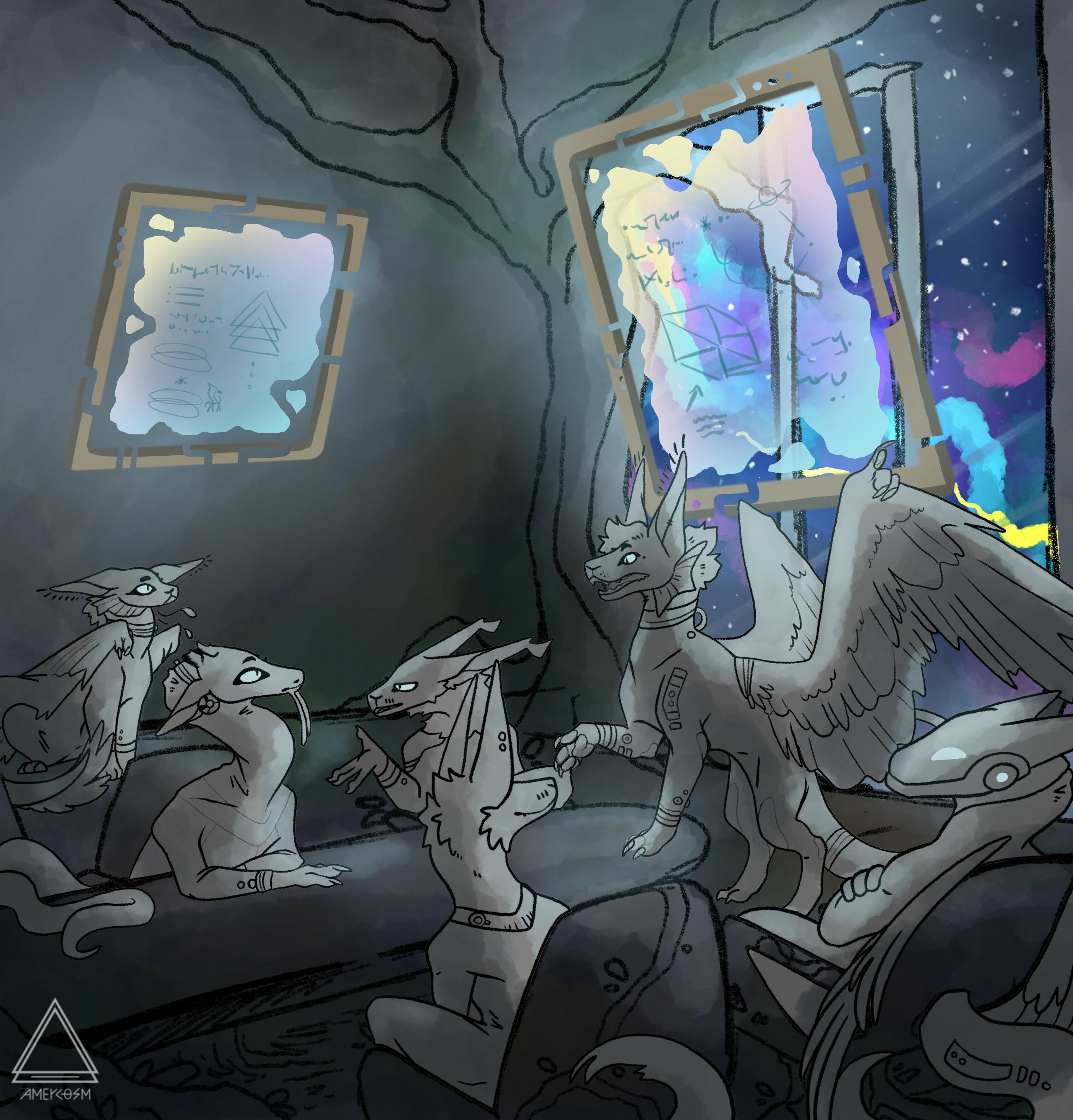
Travel Methods
Spaceship Construction
Biohull/Allumnix Hull: Allumnix is a metal-like material crafted from a mixture or iron, compressed honeycomb tree roots, and other strong natural materials. It is essentially a living metal, able to transfer aura through it or prevent it as a seal with just a change in its enchantment. It comes out as a silvery gray when first melded but slowly turns green over many years as its biomaterials show through.
Biohull Roots: Instead of welding tools to connect the hull, a special type of roots are grown over the spacecraft to connect all the pieces. These roots are cut from the dangerous honeycomb trees of the Aurix forests and controlled using magic to grow where they need to. These roots are sturdy and near impossible to break without a powerful fire or laser.
Auracore Reactor: Within every spacecraft, big and small, is an aura core. In the smaller crafts this source of aura is compressed and controlled in a spherical shape so it can be moved if necessary. This part is essential to the energy of the spacecraft.
Propulsion Rings: The more rings a spacecraft has the faster it can travel. These rings contain propulsion methods that take energy from the aura core of the craft and push it outwards, moving the craft forward. Because there are no flames, directional engines, etc, they allow the craft to move in any direction so long as the rings are position-able. In most smaller spacecraft the rings are built to be position-able.
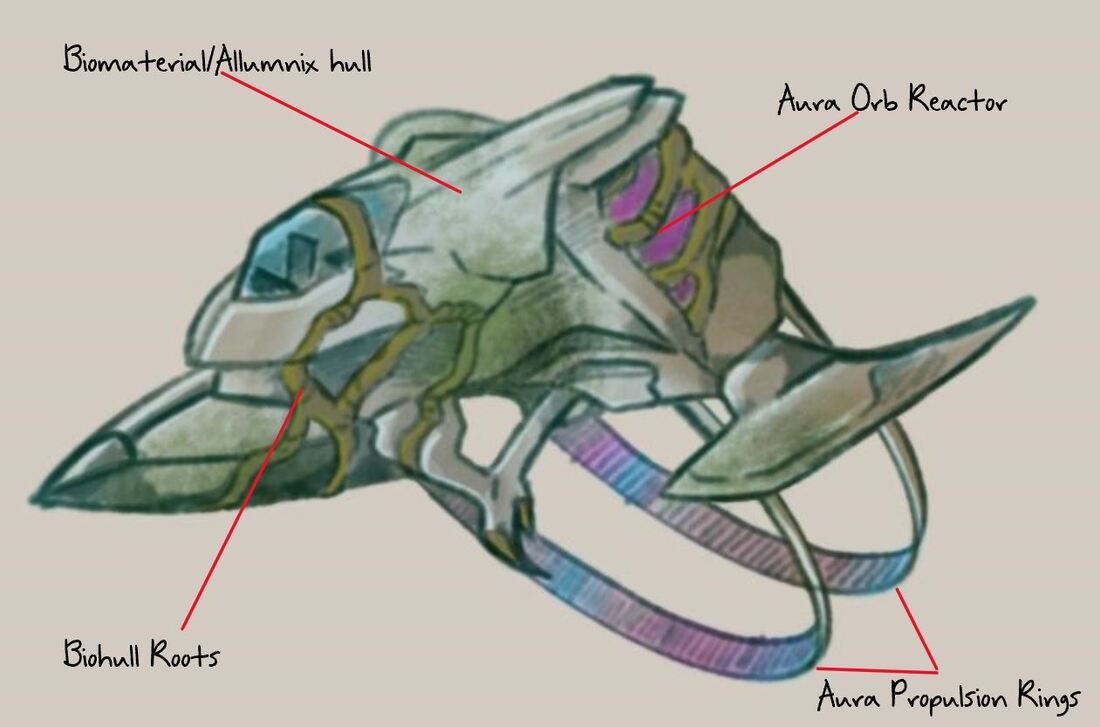
Ship Types
Voyagers are the most personalize-able ships. Aesthetic wise, they are made out of sturdy bark, biohull, and vines. The technology interfaces in them mimic the type of Retro sci-fi you'd see in 1970-80 sci-fi (Alien movie for example). Most are kitted out as personal exploration ships or messenger ships.
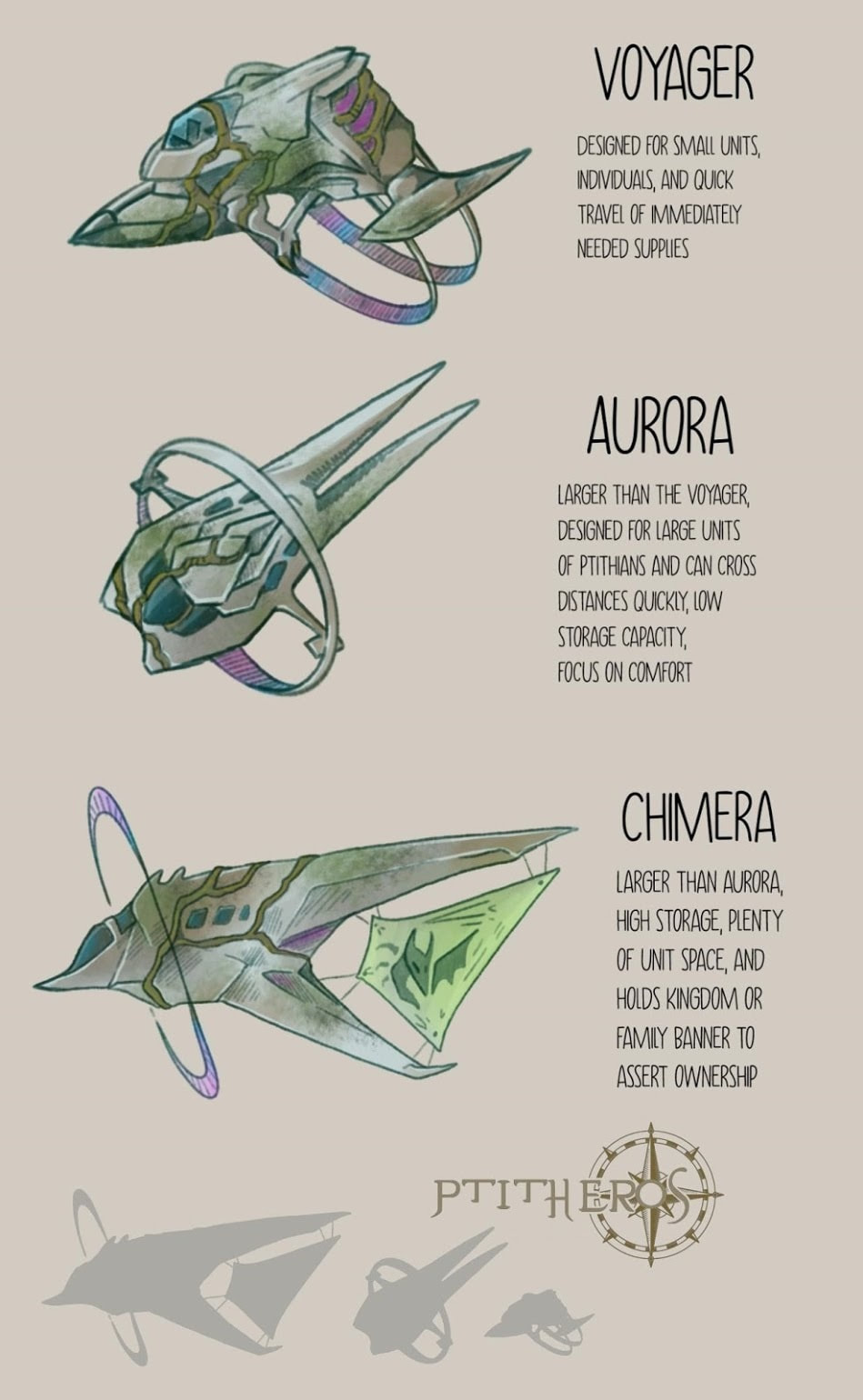
Space Gear
Diage Helmet: Built out of two layers, one an outer insulation material of thin allumnix that is sanded down and shaped to fit the head of almost any creature. Lining the inside is the special diage fabric, a fabric resolved from windiages that contains the properties of aura-insulation and recycling. However, the heavy material is left out so the helmet remains lightweight and sizable. Paneled over the front is a thin glass without any tinting, this glass can be popped off by tweaking the proper side-panel button on the helmet a few times. On the back of the helmet is the connection valve for the diage vertebrae and on the bottom is a hole to place one's head through to put the helmet on. The bottom opening has an extending circle of insulation that attaches to the neck of a diage suit. The neck lining can also be tightened into a vacuum seal if a suit if not being worn, this is not advised due to the chance of the seal breaking.
Diage Vertebrae: The connective tube for the helmet and ribcage of the gear. It has the same diage insulation on the inside but its outer material is a flexible, plastic-y, strong fabric known as allum. One end connects to the back of the helmet and the other clasps to the top end of the ribcage. A few straps extend from the bottom of the tube, these attach to the diage suit to keep the tube in place.
Diage Ribcage: The "oxygen case" of the gear set. The ribcage attaches to the back of a diage suit but has straps built in that could go around someone's shoulders or wings if the suit is not present. The piece of built like the helmet but with a denser sheet of diage fabric lining the inside. It is this unique material that circulates the breath of the wearer and replenishes the aura and oxygen within it to a usable state. The process is complex and is reliant on the properties found in windiage flesh and sap fluid.
Diage Suit: A suit designed specifically to be worn to use diage gear in the most efficient and comfortable state. The suit is made out of thermally-enchanted material so the wearer does not freeze or overheat in space.


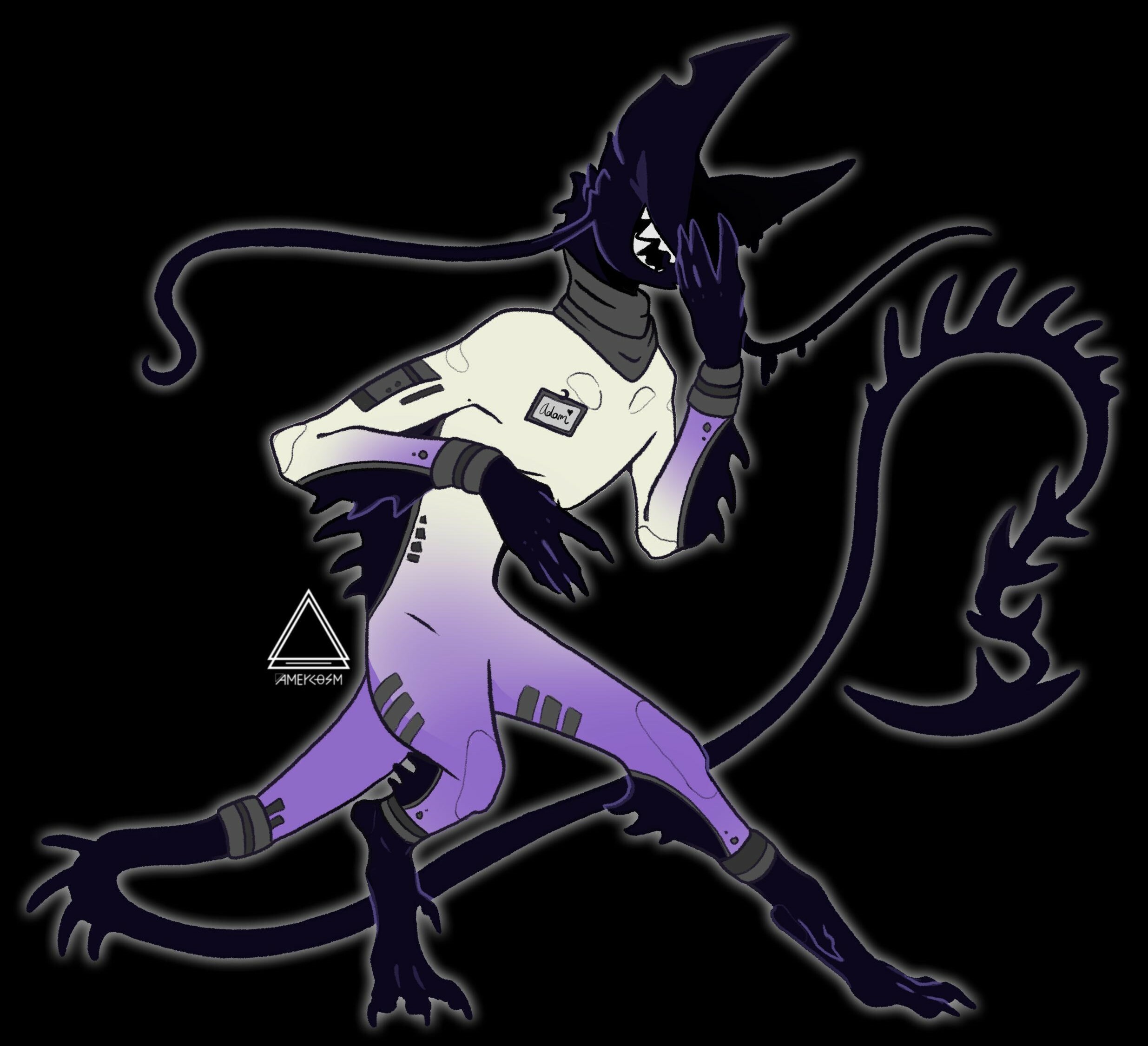
Extra
Is Tektite the first Ptithian to go to space? - Yes, Tektite is the first astronaut, along with her assisting lindost, Chaldat. She began the Space-age after she passed her technology patents on to the government bodies after her first successful Voyager ship was made.
Have new weapons been developed? - Aura capsule based weapons. Creatures can transfer their magic into the weapons and most of the space-age weapons are like light-based lasers.
Why do spaceships and stations need lindosts? - Lindosts are necessary on almost every space ship except Voyagers because their aura control is needed to handle the energy and core of the larger vessels. Such as, whenever a group is sent out on a Chimera or Aurora, one lindost is paired with them. Or, on Station Zariel, many can be found in the Aura Level of the station because they handle anything with the orb core. Lindosts who work with Ptithians and their space needs are usually there on their own terms because it interests them greatly in comparison to their usual 'job'. Ptithians who work space occupations have to get over their deep-set, natural fear of lindosts quickly if they wish to stay in the line of work.
